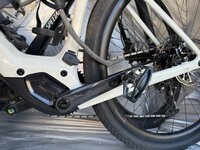Curious how much that cost in $/gram and where you felt the most benefit — climbing, general responsiveness, etc.
as you might guess, i have that spreadsheet lol. looking back it was ±4lb apples to apples, there are a few things i've forgotten or don't have weights for like bottle cages, lights, bar tape, etc. the cost per gram ranges from less than a dollar a gram to $5 a gram, but the biggest difference was absolutely the rear wheel - total weight savings 467 grams, of which 190g was going from the stock sunrace cassette to a sram 10-42 and the rest is the wheel and tire. that's an entire pound of rotating mass - imagine pouring an entire 16oz soda bottle into your tire and hub, lol. and of course nice carbon wheels are better at reducing vibration and harsh bumps, and more aero. certainly the biggest possible difference, especially with tires of the correct width for the rim (in this case they were 32mm)
the next most noticeable as a combination was going from crazy heavy freerider pro shoes, platform pedals, and aluminum cranks to super light road shoes, speedplay pedals, and carbon cranks. total reduction almost 1.5lb! now imagine a 12 oz soda can attached to each foot, going around and around and around. of course the pedals don't go around as fast as the rear tire and the weight is much closer to the center of rotation, but still very noticeable, and of course being clipped in is a whole different feeling.
after the wheels the next biggest improvement in "feel" was the one piece alpinist carbon bar, 220g of weight reduction (good value today at around $1.3/g but i think at the time it was more expensive) but a really nice low-vibration feel and super sleek look for the front end, for a non-integrated-cable bike!
in the end the bike was nicer than the s-works version with the exception of the brifters and rear derailleur. upgrading those actually wouldn't have saved meaningful weight, but as you know i'm a huge fan of electronic shifting.

